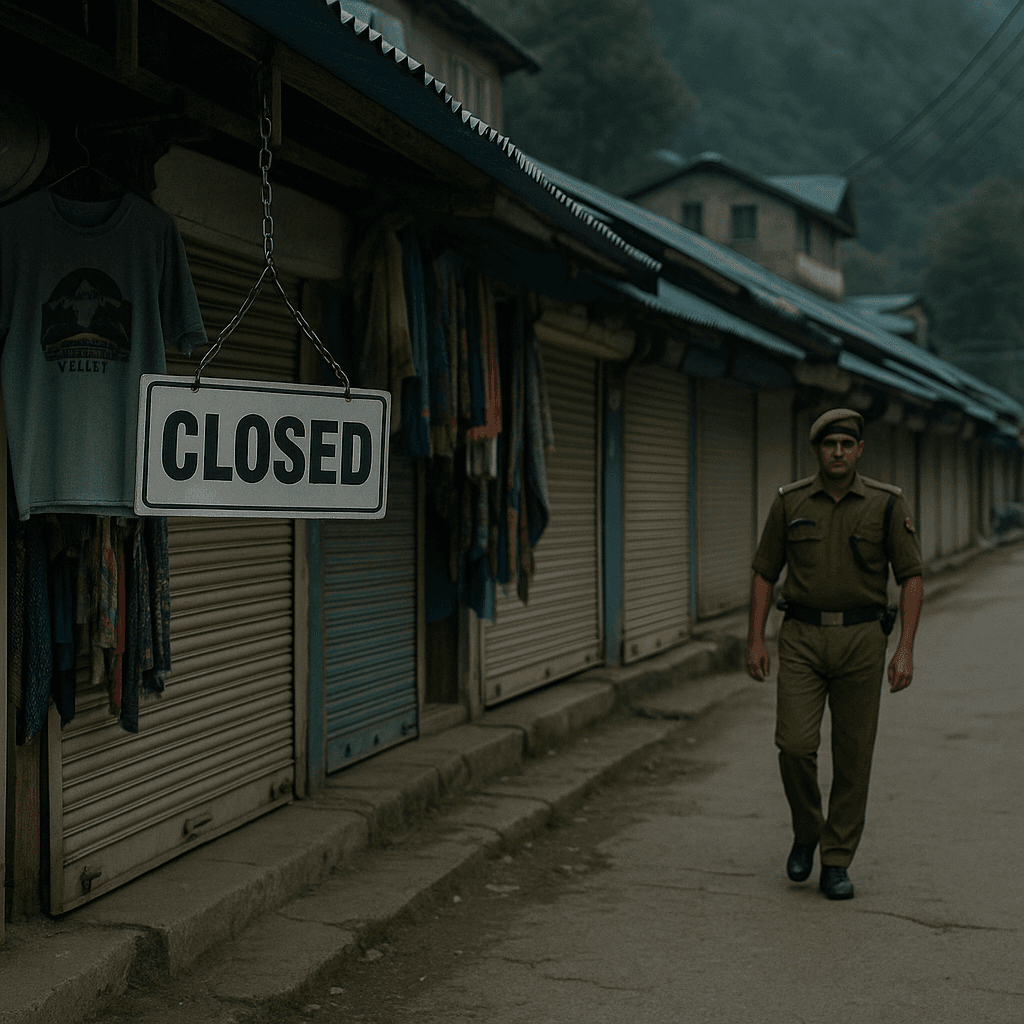On April 22, 2025, a brutal armed assault on tourists in Jammu and Kashmir’s Anantnag district claimed the lives of 26 civilians. Additionally, it left more than a dozen injured. The attack, which occurred in the scenic Baisaran Valley near Pahalgam, represents the deadliest mass-casualty incident in the region since the Pulwama bombing six years earlier.
As India grapples with the magnitude of the attack, security agencies have launched extensive search operations. Meanwhile, political leadership signals a decisive response. The fallout may reshape India’s security posture both internally and across its borders.
The Attack: Facts on the Ground
The shooting took place in the late afternoon hours. It targeted unarmed tourists hiking through Baisaran, a popular destination in the Himalayan foothills. Eyewitnesses reported sustained automatic gunfire from a concealed position on elevated ground.
According to Jammu and Kashmir police, the gunmen fled into forested terrain following the attack. No group had formally claimed responsibility at the time of reporting. However, Indian authorities have attributed the incident to terrorist actors operating in or with support from neighboring Pakistan.
Security forces sealed off ingress and egress routes. Emergency medical response teams were dispatched from nearby towns to evacuate survivors. The wounded were transferred to Anantnag District Hospital and Sher-i-Kashmir Institute in Srinagar.
Government Response: National Mourning and Mobilization
Prime Minister Narendra Modi, who was abroad at the time, immediately canceled diplomatic meetings and returned to New Delhi. Upon arrival, he chaired an emergency session of the Cabinet Committee on Security (CCS). During the session, top officials from India’s military, intelligence, and home affairs apparatus presented preliminary findings.
Defense Minister Rajnath Singh addressed the nation later that evening, promising a “loud and clear” response. “Those who planned this attack, those who carried it out, and those who supported it will all be held accountable,” Singh stated.
President Droupadi Murmu declared April 23 a day of national mourning. Indian flags were flown at half-mast, and political events across the country were suspended.
Strategic Repercussions and Policy Shifts
The central government enacted a series of policy measures in the immediate aftermath:
- Suspension of the Indus Water Treaty (IWT): India has halted key provisions of the longstanding water-sharing agreement with Pakistan. This decision cites the need to review cooperative frameworks in light of persistent cross-border hostility.
- Revocation of SAARC Visa Exemptions: Pakistani nationals currently residing in India under SAARC protocols were given 48 hours to exit the country. Meanwhile, no new entries will be permitted under the program for the foreseeable future.
- Force Posture Reinforcement: Joint teams from the Indian Army, CRPF, and Jammu and Kashmir Police have initiated large-scale cordon-and-search operations (CASO) across South Kashmir. Additionally, UAVs and SIGINT platforms are being employed to track movement in forested regions.
While the attack has not yet resulted in a cross-border strike, analysts suggest that a calibrated kinetic response remains a viable option.
A Doctrinal Crossroads: India’s Evolving Approach to Irregular Warfare
The Pahalgam massacre underscores a persistent challenge faced by India: the intersection of irregular warfare and civilian targeting. Since the 2016 Uri attack and the 2019 Pulwama bombing, India has increasingly emphasized a proactive and retaliatory approach to state-sponsored terrorism and asymmetric threats.
In 2016, India launched cross-border “surgical strikes” against insurgent camps in Pakistan-administered Kashmir. This action signaled a shift from defensive counterinsurgency to transboundary kinetic deterrence. The 2019 Balakot airstrikes, following the Pulwama suicide bombing, marked the first Indian Air Force strike inside Pakistani territory since the 1971 war.
These operations reflect a broader doctrinal evolution: India’s willingness to escalate proportionally in response to proxy warfare. While the immediate government response to Pahalgam has remained focused on internal security measures and diplomatic signals, the groundwork exists for a strategic reprisal. This is particularly true if the investigation confirms external coordination or state complicity.
Civilian Targeting as a Hybrid Warfare Tool
The targeting of unarmed civilians, particularly tourists, represents a brutal but calculated tactic within the hybrid warfare framework. Rather than engage Indian security forces directly, attackers chose a high-visibility, high-impact civilian soft target to achieve psychological disruption.
This form of irregular violence is designed to serve multiple objectives:
- Undermine confidence in state security during times of political or economic vulnerability.
- Damage tourism revenues, a key lifeline in post-pandemic Kashmir.
- Provoke overreaction that separatist or transnational propaganda outlets can leverage.
Hybrid actors operating in Jammu and Kashmir have historically employed a combination of guerrilla tactics, cyber operations, and media manipulation to influence local and international perceptions. The Pahalgam attack aligns squarely with this logic, challenging the Indian state to strike a balance between retaliation and restraint.
Regional and International Implications
The international reaction to the Pahalgam killings has been overwhelmingly supportive of India. Countries with direct counterterrorism partnerships, including the United States, France, Israel, and the United Kingdom, have issued formal condemnations. They have also pledged to share intelligence.
The response from neighboring powers has been more muted. While China condemned the attack in general terms, it refrained from assigning blame. Pakistan’s Foreign Ministry, as of this writing, has neither acknowledged the incident nor offered cooperation in any investigation.
Regionally, the attack may complicate efforts to thaw India-Pakistan relations or revitalize the South Asian Association for Regional Cooperation (SAARC). India’s suspension of SAARC visa privileges for Pakistani nationals sends a clear signal. It conveys that diplomatic normalization will not proceed under conditions of proxy aggression.
Domestic Political Climate and Counterinsurgency Challenges
The political climate surrounding the Pahalgam attack is complex. With elections approaching in several Indian states, heightened sensitivities surround national security narratives and public trust in government responses.
Additionally, India faces ongoing difficulties in balancing counterinsurgency operations with the rights and perceptions of the civilian population in Jammu and Kashmir. While operations like CASO can yield tactical results, they also carry risks of collateral displacement and further alienation of local communities.
As such, the government’s challenge lies in crafting a response that maintains national resolve without amplifying long-standing grievances. Civil-military cooperation, precision intelligence work, and information dominance will be critical to sustaining operational legitimacy.
Tourism, Fear, and the Psychological Front
Tourism is not just an economic activity in Kashmir—it is a symbolic measure of peace. Over the past three years, the region has experienced a tentative resurgence in domestic and international tourism. This has been particularly notable during summer and winter festivals. Pahalgam, with its alpine trails and cultural heritage, was emblematic of that recovery.
The April 22 attack, therefore, strikes not only at individuals but at the collective perception of safety. Travel cancellations surged within 24 hours of the incident. Hotel bookings across Anantnag and nearby regions dropped by 40% by April 23, according to early reports from local tour operators.
Combating this psychological front requires more than military security. Strategic communication, visible law enforcement presence, and public-private coordination will be essential in restoring confidence among both residents and visitors.
Conclusion
The Pahalgam attack marks a pivotal moment in India’s internal security narrative. As the nation mourns its dead, it also enters a phase of strategic recalibration. How New Delhi chooses to respond—militarily, diplomatically, and politically—will define its counterterrorism doctrine for the years ahead.
While the investigation continues, the facts so far confirm a deliberate, premeditated strike on civilians in a sensitive region. The broader implications extend beyond borders, making it a critical flashpoint in the evolving landscape of irregular warfare in South Asia.
DISCLAIMER: Links included might be affiliate links. If you purchase a product or service with the links that I provide I may receive a small commission. There is no additional charge to you.





Leave a Reply